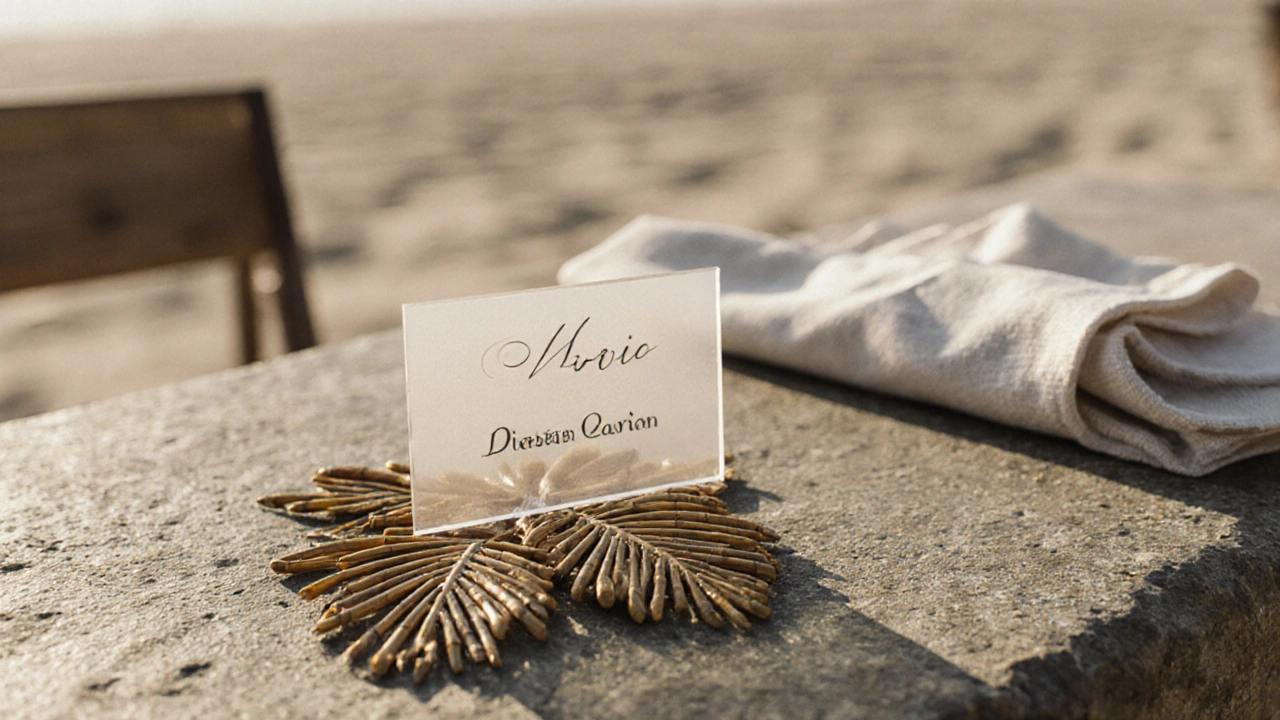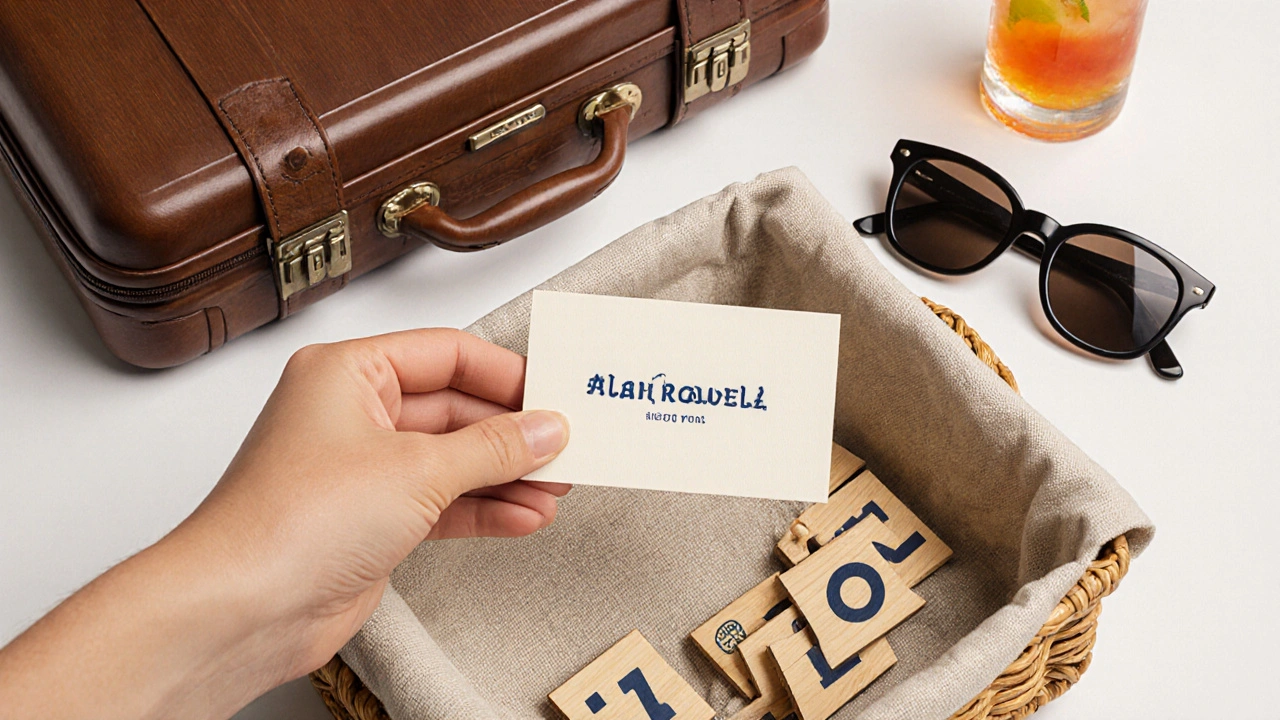Why Your Destination Wedding Needs Tough, Travel-Safe Escort Cards
Imagine this: your guests arrive in Bali after a 14-hour flight. They’re tired, jet-lagged, and holding a stack of paper cards that curl at the edges from humidity. One slips out of their purse, gets stepped on, and the name is smudged beyond reading. That’s not the first impression you want for your big day.
Escort cards at destination weddings aren’t just decorative-they’re functional. They guide guests to their tables in a place where everyone’s unfamiliar with the layout, the language, or even the weather. And unlike home weddings, these cards have to survive luggage, climate shifts, and maybe even a beach breeze. The material and design you pick can make the difference between a smooth check-in and a confused, frustrated crowd.
You’re not just choosing paper. You’re choosing durability, readability, and emotional impact-all while keeping it light enough to pack and sturdy enough to last.
Best Materials for Escort Cards That Handle Travel
Not all cardstock is made equal when it’s heading overseas. Here’s what actually works:
- Thick recycled cotton paper (300gsm+) - This is the gold standard. It’s rigid, resists moisture, and feels luxurious. Brands like Cottonwood a premium paper brand known for its 100% cotton fiber cards that resist warping in humid climates are popular among planners in tropical destinations. Unlike regular cardstock, it doesn’t curl when the air gets thick.
- Acrylic or thin plastic (0.5mm) - Waterproof and nearly indestructible. Perfect for beach weddings or monsoon seasons. These cards can be laser-engraved with names and sit on a wooden stand without bending. They’re more expensive, but guests often keep them as souvenirs.
- Recycled kraft paper with matte coating - If you’re going for rustic, earthy vibes in places like Tuscany or Costa Rica, this gives texture without falling apart. The matte finish prevents fingerprints and holds ink well.
- Thin bamboo fiber boards - Lightweight, biodegradable, and surprisingly sturdy. Used by eco-conscious couples in Bali and Kyoto. These cards have a natural grain and feel warm to the touch.
Avoid regular 250gsm cardstock, glossy photo paper, or thin cardstock. They warp in humidity, smudge in rain, and tear when stuffed into a pocket or purse. I’ve seen guests in Santorini try to tape their cards to a wall because the humidity made them bend like noodles.
Design Rules That Actually Work for International Guests
Design isn’t just about looks-it’s about clarity. Your guests might speak five different languages. They might be 70 years old with tired eyes. They might be holding a cocktail and a suitcase.
Here’s what to do:
- Use large, bold fonts - At least 18pt for names. Sans-serif fonts like Montserrat a clean, modern sans-serif typeface that’s highly legible at small sizes and on digital screens or Open Sans a widely used, neutral sans-serif font designed for readability across devices and print work better than fancy script fonts. Names should be readable from 3 feet away.
- Include table numbers, not just names - Put the table number right under the name. Don’t make guests hunt for a separate table list. A simple format: Jane Smith • Table 7 works better than just Jane Smith.
- Use high-contrast colors - Dark text on light backgrounds (black on cream, navy on white). Avoid light gray on pastel. I’ve seen couples use blush pink text on ivory paper-guests couldn’t read it under the sun.
- Keep it minimal - No clipart, no decorative borders, no tiny floral icons. One line for the name, one line for the table. Less clutter = faster recognition.
- Add a tiny icon if needed - A small fork and knife next to table numbers helps guests who don’t read English. A little airplane icon next to names of international guests? Cute, but optional.

How to Display Cards So They Don’t Get Lost
Material and design mean nothing if your display fails. You’re not in a ballroom with a 10-foot card stand. You’re on a beach, in a courtyard, or a rustic barn with no AC.
Try these setups:
- Wooden slat boards with clips - Mount a 2-foot wide board on a stand. Use small brass or copper clips to hold cards. Easy to reposition, weather-resistant, and looks natural in outdoor settings.
- Mini clotheslines with mini clothespins - String twine between two lanterns or tree branches. Clip cards with tiny wooden pins. Works great for boho or garden weddings. Guests walk through like a photo wall.
- Stacked acrylic stands - Use tiered acrylic holders (like those for restaurant menus). Place cards face-up. No wind, no falling. Easy to refill if someone misplaces theirs.
- Woven baskets with labeled dividers - Place cards in small baskets by table number. Guests pull their own. Feels personal, reduces crowding. Use linen liners to keep cards from sliding.
Avoid: leaning cards against wine bottles, taping them to rocks, or using flimsy cardboard stands. These break, blow over, or get soaked. I saw a wedding in Mexico where 40 cards ended up in a puddle because the stand collapsed.
What to Avoid: Common Destination Wedding Mistakes
Even experienced planners mess this up. Here’s what not to do:
- Don’t print names in cursive - If your cousin’s name is “Jéssica” with an accent, cursive turns it into a blob. Use clear, uppercase or lowercase print.
- Don’t forget to test print - Print a sample in the same humidity as your destination. Ink smudges differently in Bangkok than in Calgary.
- Don’t use metallic ink - Gold foil looks pretty, but it flakes off in heat and humidity. It also doesn’t scan well if someone takes a photo to text a friend.
- Don’t make them too big - Cards larger than 3x5 inches are hard to carry. Stick to postcard size.
- Don’t forget backup cards - Print 5-10 extras. Someone loses theirs. Someone’s name is misspelled. Someone’s in the wrong group. Always have spares.

Real Examples That Worked
In 2024, a couple married in Oaxaca, Mexico. They used 300gsm recycled cotton paper, printed names in dark charcoal on cream, and mounted them on a reclaimed teak board with brass clips. Guests said they kept the cards as bookmarks. Another couple in Bali used thin acrylic cards with laser-engraved names and placed them in bamboo holders shaped like palm leaves. No one lost a card. No one complained.
One couple in Sicily did it wrong: glossy cards, tiny script, and a flimsy cardboard stand. The wind blew half the cards into the olive grove. They spent 45 minutes after the ceremony hunting them down.
It’s not about being fancy. It’s about being smart.
Final Checklist Before You Print
Before you hit ‘print’ or send your files to the printer:
- Is the paper at least 300gsm or acrylic? ✅
- Are names in a bold, sans-serif font, 18pt or larger? ✅
- Is the table number clearly listed under each name? ✅
- Is the color contrast high enough to read in sunlight? ✅
- Will the display stand survive wind, rain, or heat? ✅
- Did you print 5 extra cards? ✅
- Did you test print a sample in similar conditions? ✅
If you answered yes to all, you’re ready. Your guests will find their tables without stress. They’ll remember the thought behind the detail. And that’s what makes a destination wedding feel like home-even when you’re thousands of miles away.
What’s the best paper weight for escort cards in humid climates?
Use 300gsm or heavier cotton paper. It resists warping and moisture better than standard cardstock. In places like Bali, Thailand, or the Caribbean, anything lighter than 250gsm will curl or soften within hours.
Can I use acrylic escort cards for a rustic wedding?
Yes. Thin acrylic cards look modern but can be paired with natural wood stands, woven baskets, or stone bases to balance the look. Many couples in Tuscany and Vermont use them with burlap backdrops for contrast.
Should I include the table number on the card?
Always. Guests arrive tired and confused. Seeing both name and table number together cuts down on confusion, questions, and wandering. A simple format like "Sarah Chen • Table 5" works best.
How many extra escort cards should I print?
Print at least 5-10 extra cards. Things happen: names get misspelled, guests arrive late, cards get lost, or someone changes their mind about seating. Having spares prevents last-minute panic.
Is it okay to use handwritten escort cards for a destination wedding?
Only if you’re okay with risk. Handwriting can be beautiful, but it’s harder to read in sunlight, smudges easily in humidity, and takes hours to produce. For destination weddings, printed cards are more reliable. If you want personal touches, use printed names with a hand-drawn border or wax seal.
